Want to create a website without needing to know how to code? PHP CMS platforms are here to help! They have easy-to-use interfaces and lots of features, making website building a breeze. But with so many choices, picking the right one can be tough. In this article, we’ll look at what to think about when choosing a Best PHP CMS. This will help developers make smart choices that are good for their projects and careers. Whether you’re new to coding or have been doing it for a while, understanding PHP CMS options is key to succeeding in web development.
What is CMS?
A Content Management System (CMS) is like a toolbox for building websites quickly and easily. It gives you everything you need to manage your site’s content and add cool features without hassle.
Designers use different tools and coding languages, such as HTML, ASP, PHP, CSS, and JavaScript. However, you might have yet to learn how these work. CMS platforms often use them behind the scenes to make things simple and easy to use.
PHP CMS, short for PHP Content Management System, is a software application or platform built using the PHP programming language. It enables users to create, manage, and modify digital content without requiring advanced technical knowledge. With PHP CMS, users can easily develop and organize various types of content, including text, images, videos, and documents, and publish them on websites or other digital platforms.
Best PHP CMS Platforms For Developers in 2024
WordPress:
WordPress stands out as a leading open-source content management system (CMS), powering countless websites globally since its inception as a blogging platform in 2003. Over time, it has transformed into a versatile CMS capable of supporting various website types, including blogs, e-commerce platforms, and corporate sites.

With its user-friendly interface, WordPress enables users to effortlessly create, edit, and publish content without requiring extensive technical expertise. Its array of customizable themes and templates empowers users to control the design and layout of their websites. Additionally, WordPress offers a plethora of plugins, enhancing website functionality with ease.
WordPress stands as a top choice among PHP CMS platforms, offering versatility, scalability, and robust community support. With millions of websites already leveraging its capabilities, WordPress continues to empower users to create compelling online experiences effortlessly.
Pros:
- User-friendly interface: WordPress offers an intuitive dashboard, making it easy for users to create and manage content without technical expertise.
- Extensive plugin ecosystem: With thousands of plugins available, users can extend WordPress’s functionality to meet their specific needs, whether it’s SEO optimization, e-commerce integration, or social media sharing.
- Customization options: Users can choose from a wide range of themes and customize them to create unique designs. WordPress’s flexible architecture also allows custom development to tailor the CMS to specific requirements.
Cons:
- Security vulnerabilities: Due to its popularity, WordPress is a frequent target for hackers. Users must regularly update plugins and themes and implement security measures to mitigate risks.
- Performance issues: WordPress sites may experience performance issues as websites grow in complexity, especially if not optimized properly. Caching and performance optimization techniques are often necessary to maintain speed and reliability.
Headless CMS vs WordPress
Magento:
Magento is a robust e-commerce platform known for its scalability and extensive feature set. It caters to businesses of all sizes, from small startups to large enterprises, seeking a powerful solution for online selling. Moreover, It is designed to handle large catalogs and high traffic volumes, making it suitable for growing businesses and enterprise-level e-commerce sites.
Supported by a vibrant developer community, Magento receives regular updates and patches, further enhancing its capabilities. With the introduction of Magento 2, the platform has undergone significant enhancements, solidifying its position as a leading PHP-based content management system for online retail.

Furthermore, Magento’s extensive developer community ensures ongoing support and innovation, making it a preferred choice for those looking to build thriving online retail businesses. With its reputation as one of the premier PHP CMS frameworks, Magento continues to evolve and adapt, setting the standard for e-commerce excellence in the digital landscape.
Pros:
- Advanced features: Magento offers a comprehensive set of features for managing products, orders, payments, and customer accounts. It supports complex pricing structures, promotional campaigns, and multi-store setups.
- Customization options: With its modular architecture and extensive API, Magento provides ample opportunities for customization and integration with third-party systems.
- Community and enterprise editions: Magento offers open-source (Community) and enterprise-level (Enterprise) editions, catering to businesses with varying needs and budgets.
Cons:
- Complexity: Magento’s rich feature set has a steep learning curve, especially for non-technical users. Setting up and managing a Magento store may require professional assistance or dedicated resources.
- Maintenance and updates: Keeping a Magento store up-to-date requires regular maintenance, including security patches, performance optimization, and compatibility checks with extensions and themes.
Joomla:
Joomla is a popular PHP CMS known for its effectiveness in creating portfolio and blogging websites. It balances ease of use and advanced functionality, making it a popular choice among developers and site owners. Joomla boasts a plethora of designs and extensions, allowing you to add extra features to your web apps effortlessly. Trusted by big names like eBay, Barnes & Noble, and IKEA, Joomla accounts for 6% of all websites on the internet, with over 2 million users and counting. It offers intuitive UI, scalability features, and regular security updates to keep your site safe from online threats.

Pros:
- User-friendly interface: Joomla offers a user-friendly admin panel with clear navigation and intuitive content management tools, making it accessible to all skill levels.
- Extensibility: Joomla features a robust extension ecosystem, with thousands of extensions available to add new features and functionality to your website. These include extensions for SEO, e-commerce, social networking, and more.
- Multilingual support: Joomla provides built-in support for creating multilingual websites, allowing users to quickly translate content and cater to a global audience.
Cons:
- Limited theme options: Compared to platforms like WordPress, Joomla has a smaller selection of themes available, which may limit design options for some users.
- Security concerns: Joomla is susceptible to security vulnerabilities if not properly maintained, like any popular CMS. Users must stay vigilant and regularly update Joomla core, extensions, and themes to mitigate risks.
Drupal:
Drupal is a highly acclaimed content management system (CMS) that’s written in PHP. It’s renowned for its flexibility, scalability, and robustness, making it a preferred choice for building a diverse range of websites, from personal blogs to enterprise-level applications.
One of Drupal’s standout features is its modular architecture. This architecture allows developers to extend and customize its functionality through modules and themes. Modules are packages of code that add specific features or functionality to a Drupal site, while themes control the visual presentation and layout. This flexibility enables developers to create tailored solutions that meet the unique requirements of each project.
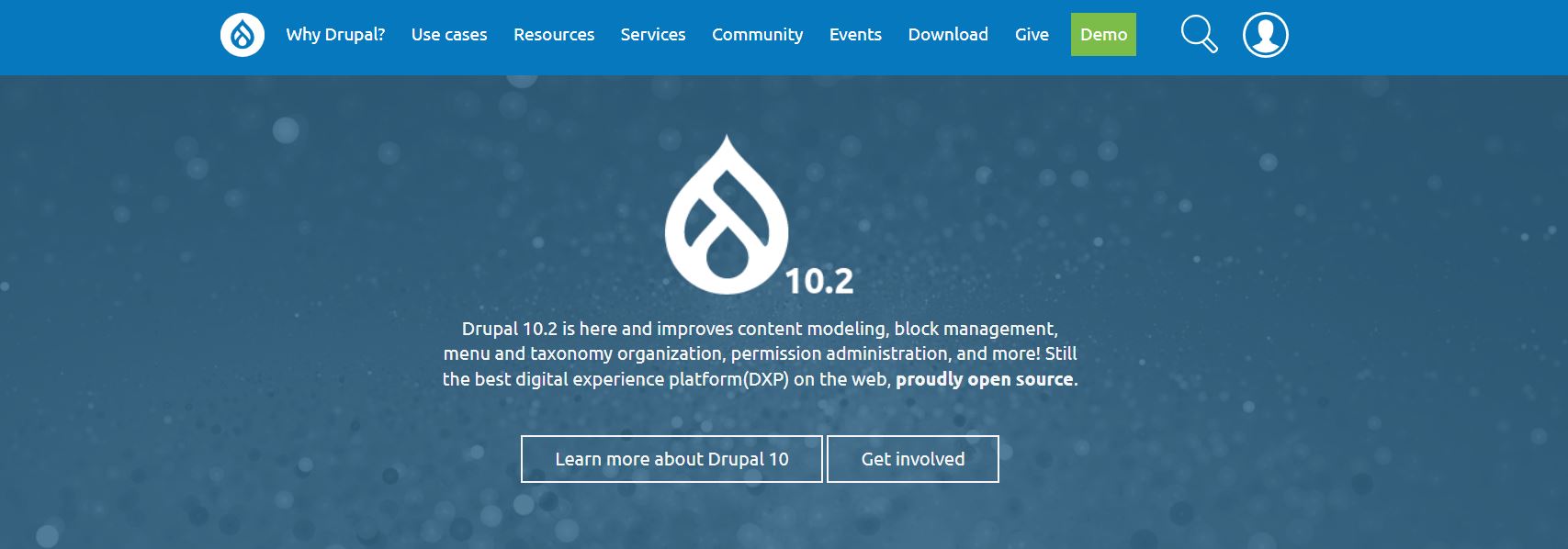
Another key strength of Drupal is its vibrant and supportive community. The Drupal community is composed of developers, designers, and enthusiasts who collaborate to improve the platform, create new modules and themes, and provide support to users. This active community ensures that Drupal remains up-to-date, secure, and well-supported.
Pros:
- Scalability: Drupal is designed to handle large and complex websites efficiently, making it suitable for high-traffic sites and enterprise-level applications. Its modular architecture allows for scalability and flexibility.
- Security: Drupal strongly focuses on security, with dedicated security team members actively monitoring and patching vulnerabilities. Regular security updates ensure that Drupal sites remain secure and protected against threats.
- Flexibility and customization: Drupal offers extensive customization options, allowing developers to create highly tailored solutions to meet specific project requirements. Its flexible content modeling capabilities enable the creation of complex data structures and workflows.
Cons:
- Steep learning curve: Drupal’s advanced features and complex architecture may present a steep learning curve for beginners. Users with limited technical expertise may struggle and need help getting started.
- Limited theme options: Drupal’s theme ecosystem is smaller than that of platforms like WordPress, which may limit design options for some users. Custom theming or modification may be necessary to achieve specific design requirements.
OctoberCMS:
OctoberCMS, a free and open-source PHP CMS built on the Laravel framework, offers flexibility, simplicity, and readiness for creating retina-ready websites and applications. While it may not have the same level of recognition as other CMS platforms, OctoberCMS has garnered popularity among developers and small to medium-sized businesses due to its ease of use, adaptability, and expandability.

Built on the Laravel framework, OctoberCMS offers scalability and versatility in creating responsive web applications. Developers can harness its potential with minimal effort, making it an attractive option for those seeking a robust yet accessible CMS solution.
Pros:
- Laravel integration: OctoberCMS leverages the power of the Laravel framework, providing developers with a robust foundation for building custom web applications. Laravel’s expressive syntax and modern features enhance development productivity and code maintainability.
- Simple yet powerful: OctoberCMS strikes a balance between simplicity and functionality, offering essential features for content management while allowing developers to extend their capabilities through plugins and custom code.
- Extendable: OctoberCMS features a plugin system that allows developers to extend its functionality easily. The marketplace offers a variety of plugins for adding features such as SEO optimization, e-commerce, and form builders.
Cons:
- Limited documentation: While OctoberCMS has extensive documentation covering core features and concepts, some areas may need more detailed documentation or examples. Users may need to rely on community forums or experimentation to address specific challenges.
- Smaller ecosystem: Compared to more established CMS platforms like WordPress or Drupal, OctoberCMS has a smaller ecosystem of themes, plugins, and extensions. Users may need more time in custom development or third-party integrations to meet specific project requirements.
OpenCart:
Opencart stands out as a top choice among PHP-based content management systems, particularly for building eCommerce websites. Its open-source nature allows PHP developers to easily implement their own updates, while its intuitive user interface makes it accessible for all users. With support for numerous languages and unlimited product categories, Opencart caters to even the largest inventories, providing ample opportunities for comprehensive online stores.
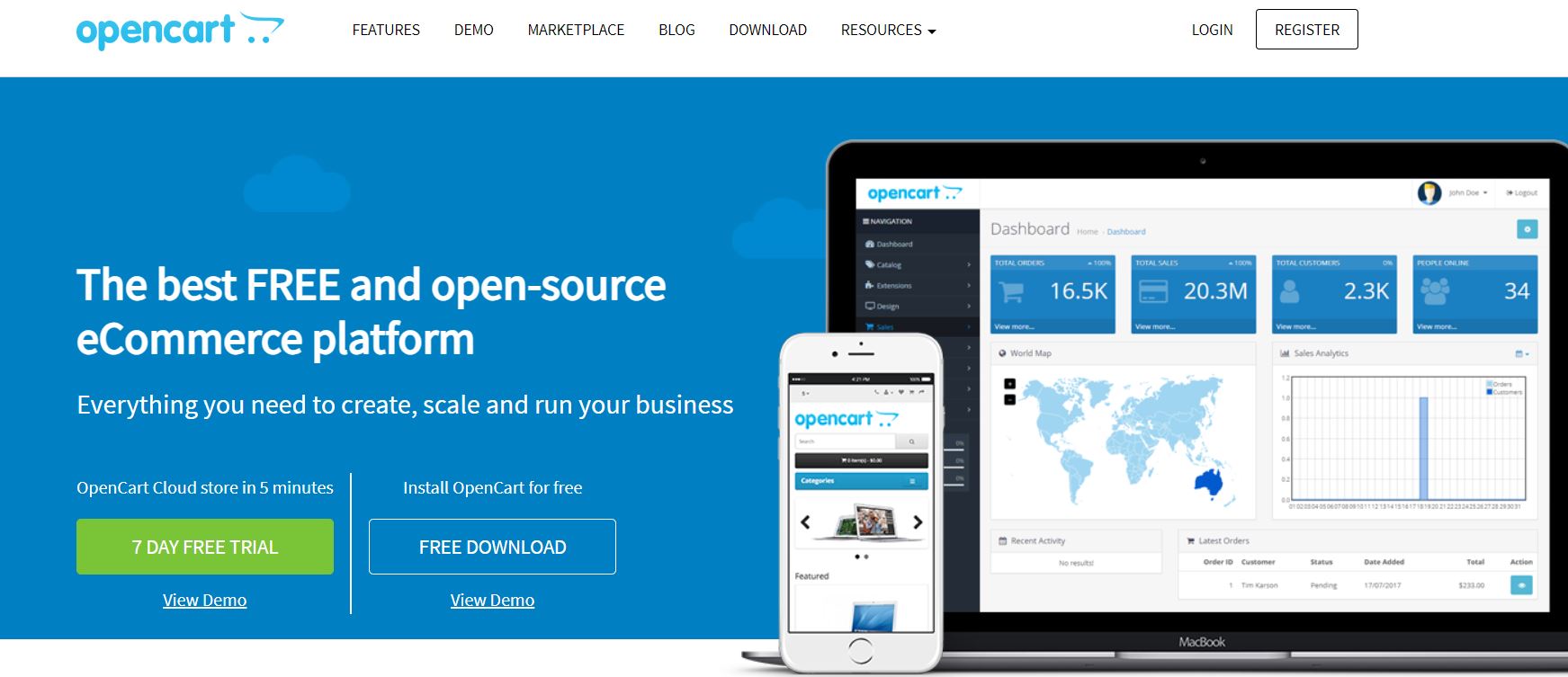
Developers benefit from Opencart’s fully-featured eCommerce capabilities, supported by a community of over 95,000 forums. While technical knowledge may be required for customization, Opencart offers reliability and stability for building online stores. However, like any CMS, sites may experience performance issues during traffic spikes, although solutions such as OpenCart hosting on Devrims can provide faster page loading speeds for improved user experience.
Pros:
- Easy setup: OpenCart’s installation process is straightforward and requires minimal technical expertise. Thanks to its user-friendly installer and intuitive admin interface, users can set up a fully functional online store within minutes.
- Extensive feature set: Despite its lightweight nature, OpenCart offers a comprehensive set of features for managing products, orders, customers, and payments. It supports multiple currencies, tax rates, shipping methods, and payment gateways out of the box.
- Customization options: OpenCart provides users with ample customization opportunities through themes and extensions. The marketplace offers a variety of themes and extensions to enhance the appearance and functionality of your online store.
Cons:
- Maintenance overhead: OpenCart requires regular maintenance to ensure optimal performance and security. Users must stay updated with the latest software updates, security patches, and extension compatibility checks.
- Limited built-in features: Unlike more advanced e-commerce platforms like Magento or WooCommerce, OpenCart may lack certain advanced features. Users may need to rely on third-party extensions or custom development to meet specific requirements.
Craft CMS:
Craft is a newer PHP-based content management system that may have a smaller user base, but don’t let that deter you. While it may not be as popular among users, it’s highly regarded by developers for its developer-centric approach.
Craft offers developers the flexibility to create their own front-end environments, provided they have knowledge of HTML and CSS. Despite this requirement, it boasts a clean backend interface, making it easy for content editors to navigate and publish content frequently.
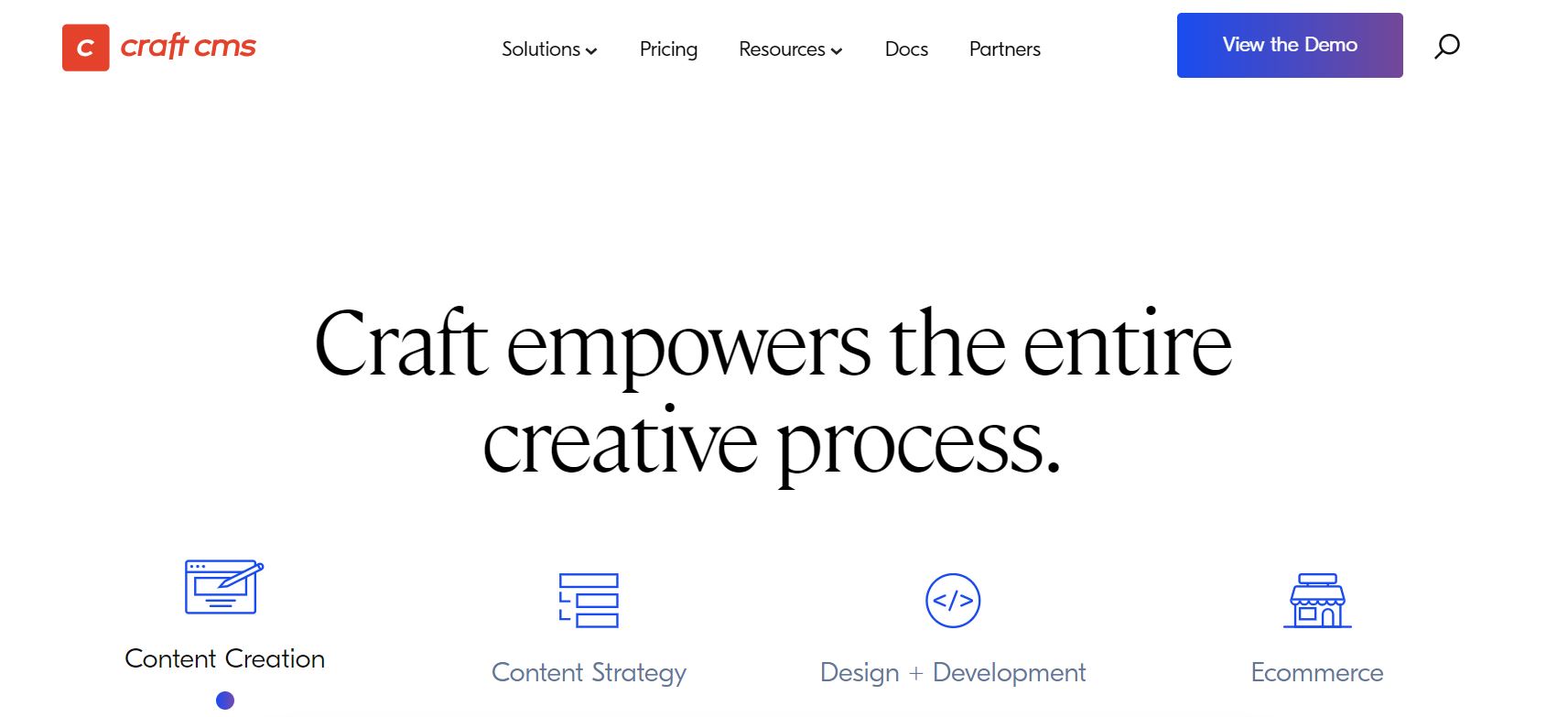
One of Craft’s standout features is its lightweight nature, ensuring smooth integration with hosting providers without causing performance issues. While it may not be open-source, Craft compensates with robust commercial features, developer-friendly functionalities, and effective security measures.
If Craft’s pricing or plugin options don’t meet your needs, consider exploring other PHP CMS options from the list. However, for developers seeking a streamlined and efficient CMS tailored to their needs, Craft proves to be a worthy contender.
Pros:
- Elegant design: Craft CMS boasts a clean and intuitive user interface, providing content editors with a seamless editing experience. Its minimalist design focuses on usability and clarity, allowing users to focus on creating and managing content effortlessly.
- Flexible content modeling: Craft CMS features a flexible content modeling system that allows developers to define custom content structures and relationships. This enables the creation of complex data-driven websites and applications tailored to specific project requirements.
- Developer-friendly: Craft CMS prioritizes developer experience, offering a modern and well-documented API, command-line tools, and debugging utilities. Its modular architecture and extensibility make it a favorite among developers seeking efficient workflows and custom solutions.
Cons:
- License cost: Craft CMS requires a commercial license for production use, which may deter budget-conscious projects or individuals. While the license fee includes access to updates and support, some users prefer free or open-source alternatives.
- Limited ecosystem: Compared to more established CMS platforms like WordPress or Drupal, Craft CMS has a smaller ecosystem of themes, plugins, and extensions. Users may need to rely more on custom development or third-party integrations to extend its functionality.
TYPO3
TYPO3 stands out as one of the top PHP CMS platforms available, compatible with various operating systems such as Windows, Linux, macOS, FreeBSD, and OS/2. It excels in powering the portals and eCommerce platforms of large companies, backed by a robust community for ongoing support and collaboration.
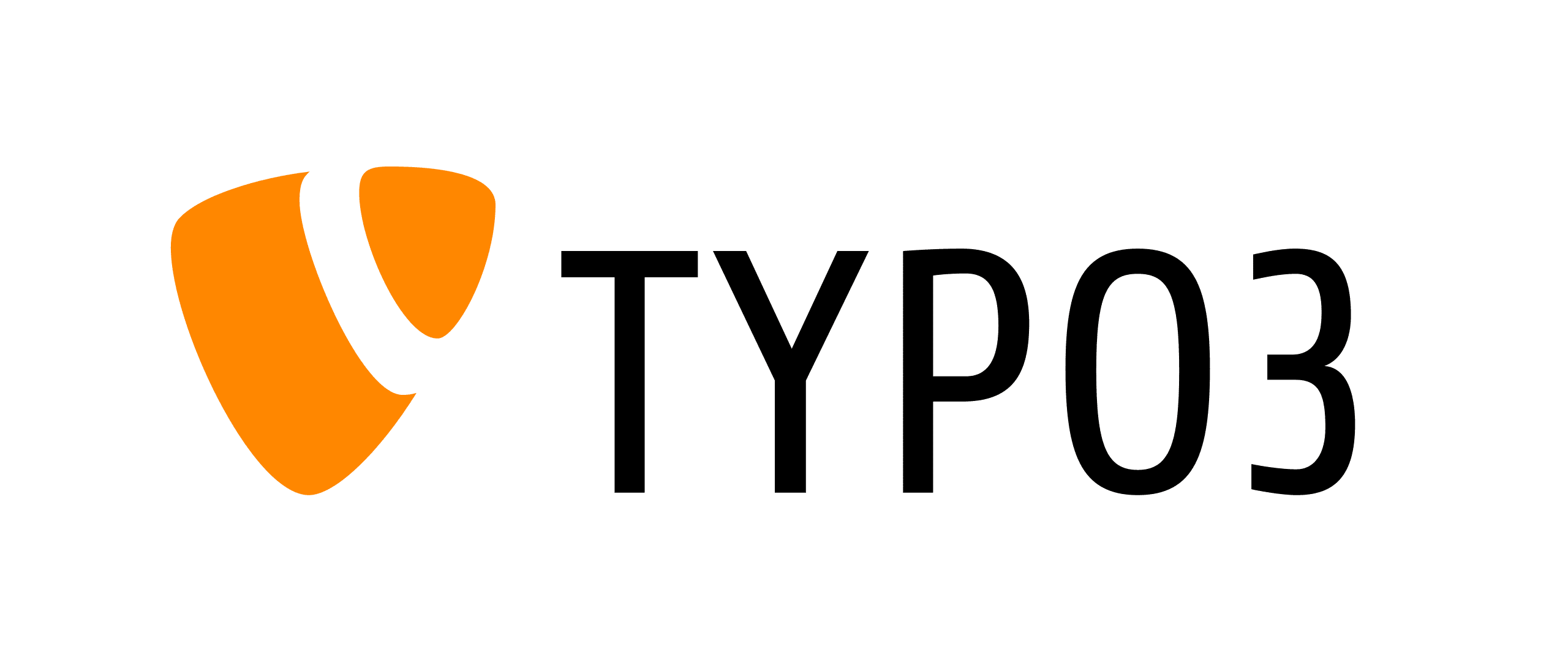
A key feature of TYPO3 is its separation of content and code, offering users unparalleled flexibility. With support for over 50 languages and integrated localization, TYPO3 effortlessly caters to users worldwide. Installation is quick and easy, requiring just a few simple steps.
Despite its strengths, TYPO3 may pose challenges in terms of configuration and training costs, both in terms of human capital and finances. However, its ability to manage content and code independently makes it a favorite among developers seeking a versatile CMS solution.
Pros:
- Scalability: TYPO3 is built for scalability, with features for managing large volumes of content, users, and traffic. Its robust architecture and caching mechanisms ensure optimal performance even for high-traffic websites and complex content structures.
- Enterprise-level features: TYPO3 offers a wide range of features for enterprise-level content management, including multi-site management, versioning, workflow management, and granular user permissions. It caters to the needs of large organizations with complex requirements.
- Extensibility: TYPO3 features a powerful extension framework that allows developers to extend its functionality with custom plugins and modules. The TYPO3 Extension Repository (TER) offers many extensions for adding new features and integrations.
Cons:
- Complexity: TYPO3 is known for its complexity and steep learning curve for beginners. Mastering its advanced features and customization options may require significant time and effort, especially for users with limited technical expertise.
- Resource-intensive: TYPO3’s robustness comes at the cost of increased server requirements and resource consumption. Hosting and infrastructure costs may be higher than simpler CMS platforms, especially for large-scale installations.
ExpressionEngine
ExpressionEngine emerges as one of the top PHP-based content management systems, particularly suitable for websites managing large volumes of content. Renowned for its versatility, ExpressionEngine boasts an architecture that allows for seamless modification with custom scripts to enhance functionality.
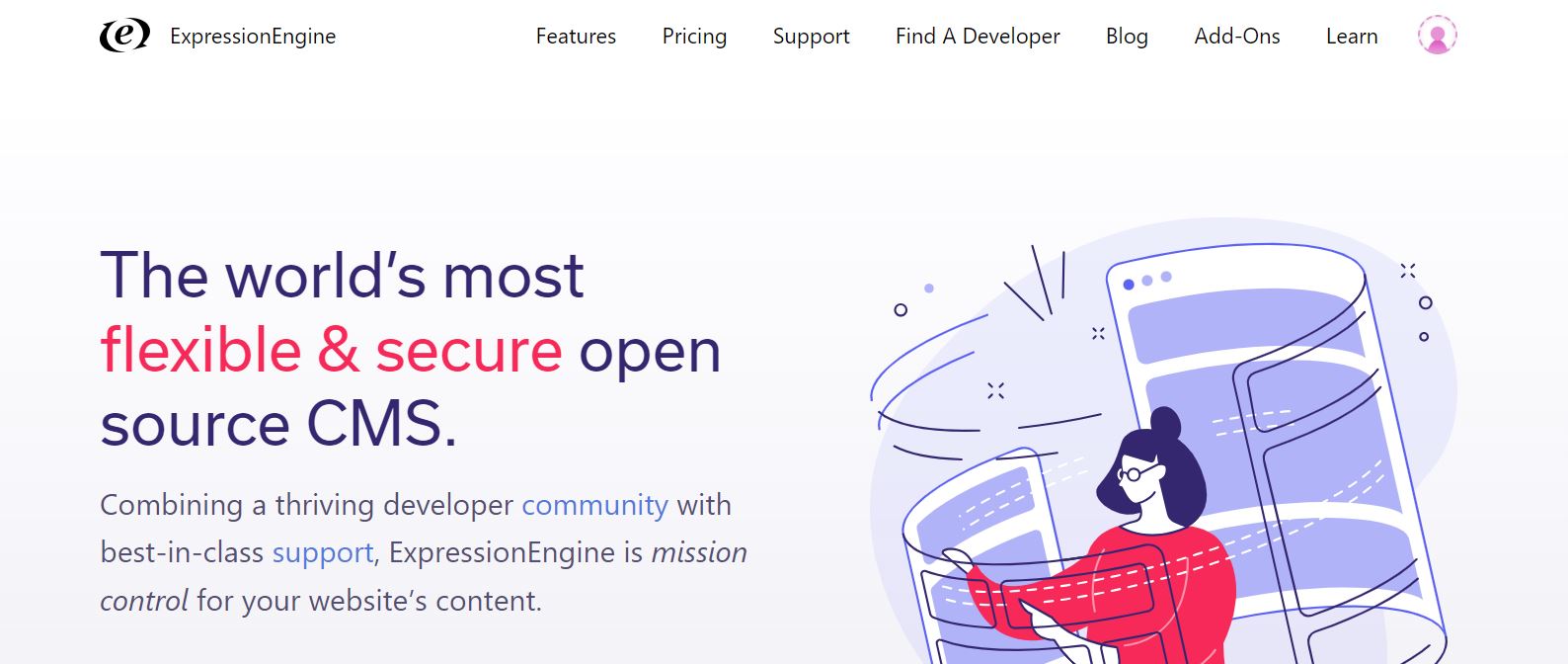
ExpressionEngine offers a range of features including custom edit forms, HTML-agnostic templates, preview windows, SEO integration, and enhanced security. However, navigation and content editing may be challenging due to context boxes, and the developer network support may not be as robust as desired. Additionally, support for third-party plugins or themes may be limited.
Pros:
- Flexibility: ExpressionEngine offers unparalleled content modeling and templating flexibility, allowing developers to create highly customized websites and applications tailored to specific project requirements. Its template language and tag-based architecture provide fine-grained control over content presentation and behavior.
- Modular architecture: ExpressionEngine features a modular architecture that allows developers to extend its functionality with custom modules, plugins, and extensions. The marketplace offers a variety of third-party add-ons for adding new features and integrations.
- User-friendly interface: ExpressionEngine boasts a user-friendly admin interface that makes it easy for content editors to create and manage content without technical expertise. Its intuitive content editing tools and drag-and-drop functionality streamline the content management process.
Cons:
- License cost: ExpressionEngine requires a commercial license for production use, which may be a barrier for budget-conscious projects or individuals. While the license fee includes access to updates and support, some users prefer free or open-source alternatives.
- Limited ecosystem: Compared to more established CMS platforms like WordPress or Drupal, ExpressionEngine has a smaller ecosystem of themes, plugins, and extensions. Users may need to rely more on custom development or third-party integrations to extend its functionality.
PyroCMS
PyroCMS stands out as an open-source content management system (CMS) built on the PHP programming language and the Laravel framework. It offers a flexible and intuitive platform for website and web application creation and management. PyroCMS aims to strike a balance between simplicity and extensibility, catering to both developers and content creators.
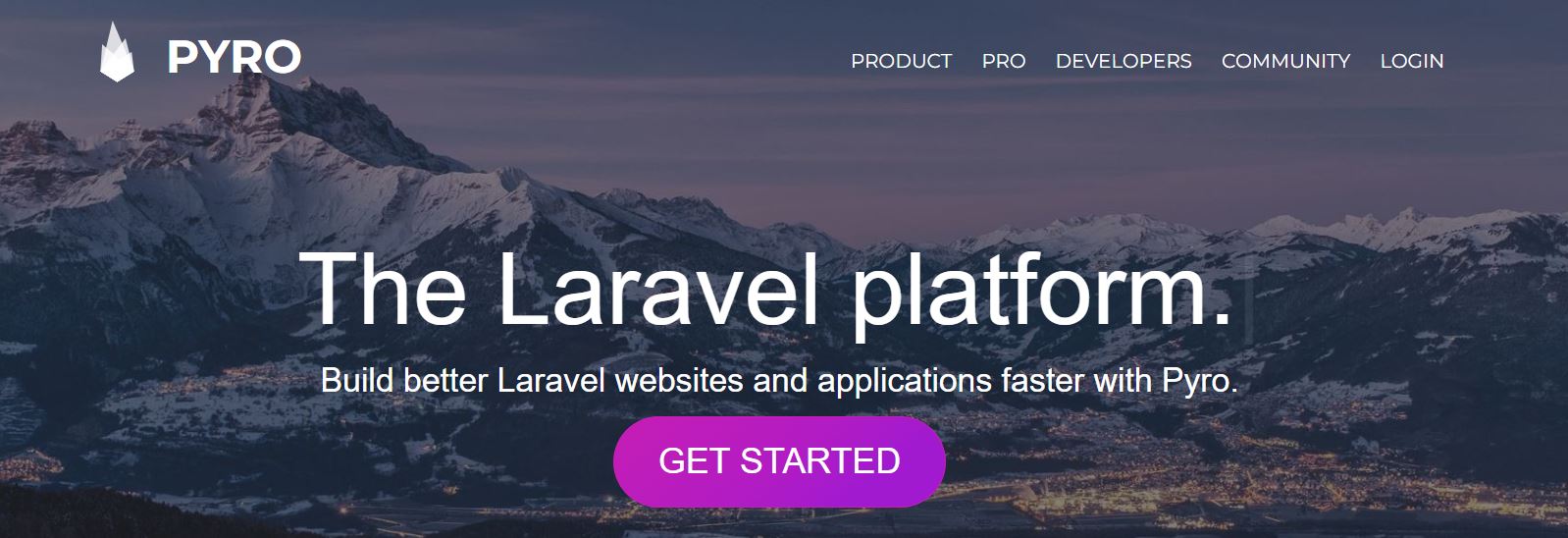
With a modular architecture, PyroCMS allows users to customize and extend its functionality using modules, themes, and addons. Its visual user interface simplifies content, template, and navigation management, enabling easy website updates without advanced technical skills.
Pros:
- Lightweight and fast: PyroCMS is designed for speed and performance, with optimized code and minimal overhead. Its lightweight architecture ensures fast page load times and efficient resource utilization, even for high-traffic websites.
- Modular architecture: PyroCMS features a modular architecture that allows developers to extend its functionality with custom modules, plugins, and themes. The built-in module and theme management tools make installing, enabling, and configuring extensions easy.
- User-friendly interface: PyroCMS boasts a user-friendly admin interface that makes it easy for content editors to create and manage content without technical expertise. Its intuitive content editing tools and drag-and-drop functionality streamline the content management process.
Cons:
- Limited documentation: While PyroCMS has extensive documentation covering core features and concepts, some areas may need more detailed documentation or examples. Users may need to rely on community forums or experimentation to address specific challenges.
- Smaller ecosystem: Unlike more established CMS platforms like WordPress or Drupal, PyroCMS has a smaller ecosystem of themes, plugins, and extensions. Users may need more time in custom development or third-party integrations to meet specific project requirements.
Contao
Contao is a PHP-based content management system (CMS) that helps you create and manage websites easily. It’s a user-friendly platform that doesn’t require advanced technical skills to use, making it accessible to beginners and experienced users alike.
One of the great things about Contao is its simplicity. It comes with a straightforward interface that allows you to build and customize your website without much hassle. You can easily add content, such as text, images, and videos, using the built-in editor, and organize it into pages and sections.

Contao is a reliable and user-friendly CMS that simplifies the process of creating and managing websites. Whether you’re a beginner or an experienced user, Contao provides the tools and features you need to build a professional-looking website with ease.
Pros:
- Accessibility: Contao prioritizes accessibility, offering features for creating websites that comply with web accessibility standards. Its built-in accessibility tools and guidelines ensure that websites are usable and accessible to users with disabilities.
- User-friendly interface: Contao boasts a user-friendly admin interface that makes it easy for content editors to create and manage content without technical expertise. Its intuitive content editing tools and drag-and-drop functionality streamline the content management process.
- Extensibility: Contao features a modular architecture that allows developers to extend its functionality with custom modules, plugins, and themes. The built-in extension repository offers a variety of extensions for adding new features and integrations.
Cons:
- Limited scalability: While Contao is suitable for small to medium-sized websites, there may be better choices for large-scale installations or complex web projects. Performance issues may arise as the website grows in content, traffic, and functionality.
- Limited ecosystem: Compared to more established CMS platforms like WordPress or Drupal, Contao has a smaller ecosystem of themes, plugins, and extensions. Users may need to rely more on custom development or third-party integrations to extend its functionality.
Neos CMS
Neos CMS is a modern and innovative content management system (CMS) built using PHP. It’s designed to provide a flexible and user-friendly platform for creating and managing websites and digital experiences.
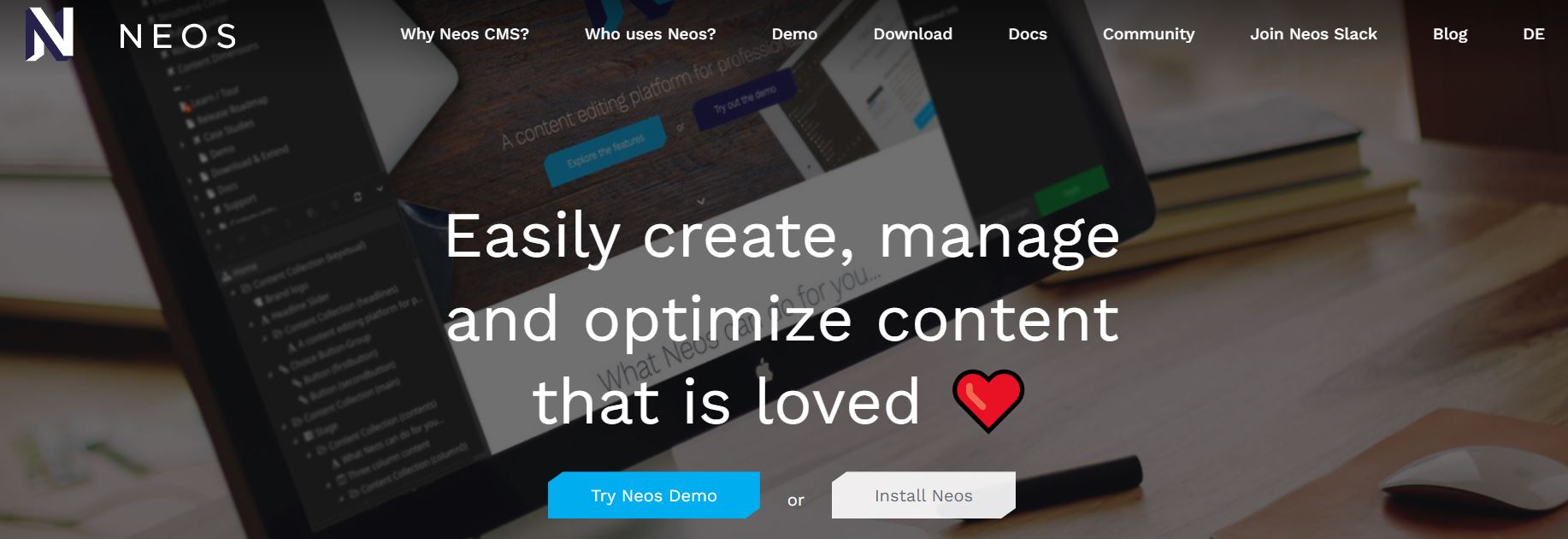
One of the key features of Neos CMS is its emphasis on content creation and editing. It offers a highly intuitive and visual interface that makes it easy for users to create and edit content directly on the page, without needing to understand complex technical concepts. This “what you see is what you get” (WYSIWYG) approach simplifies the content creation process and empowers users to make changes quickly and efficiently.
Pros:
- Real-time editing: Neos CMS features real-time editing capabilities that allow multiple users to collaborate on content simultaneously. Changes are synced in real time, providing a seamless editing experience and enabling efficient collaboration between content creators.
- Flexible content modeling: Neos CMS offers a flexible content modeling system that allows developers to define custom content structures and relationships. Its intuitive content editing tools and drag-and-drop functionality streamline the content management process.
- Modern architecture: Neos CMS is built on modern technologies such as PHP, Node.js, and React.js, providing a robust and scalable foundation for building dynamic web projects. Its modular architecture and API-first approach enable seamless integration with third-party systems and services.
Cons:
- Learning curve: While Neos CMS offers a user-friendly interface for content editors, mastering its advanced features and customization options may require some learning curve, especially for beginners. Users with limited technical expertise may need to invest time in learning the platform’s concepts and best practices.
- Limited ecosystem: Compared to more established CMS platforms like WordPress or Drupal, Neos CMS has a smaller ecosystem of themes, plugins, and extensions. Users may need to rely more on custom development or third-party integrations to extend its functionality.
ButterCMS
ButterCMS is a headless CMS that simplifies content management for developers. It offers a modern and developer-friendly API, seamless integration capabilities, and a user-friendly admin interface, making it an ideal choice for creating dynamic and content-driven applications.
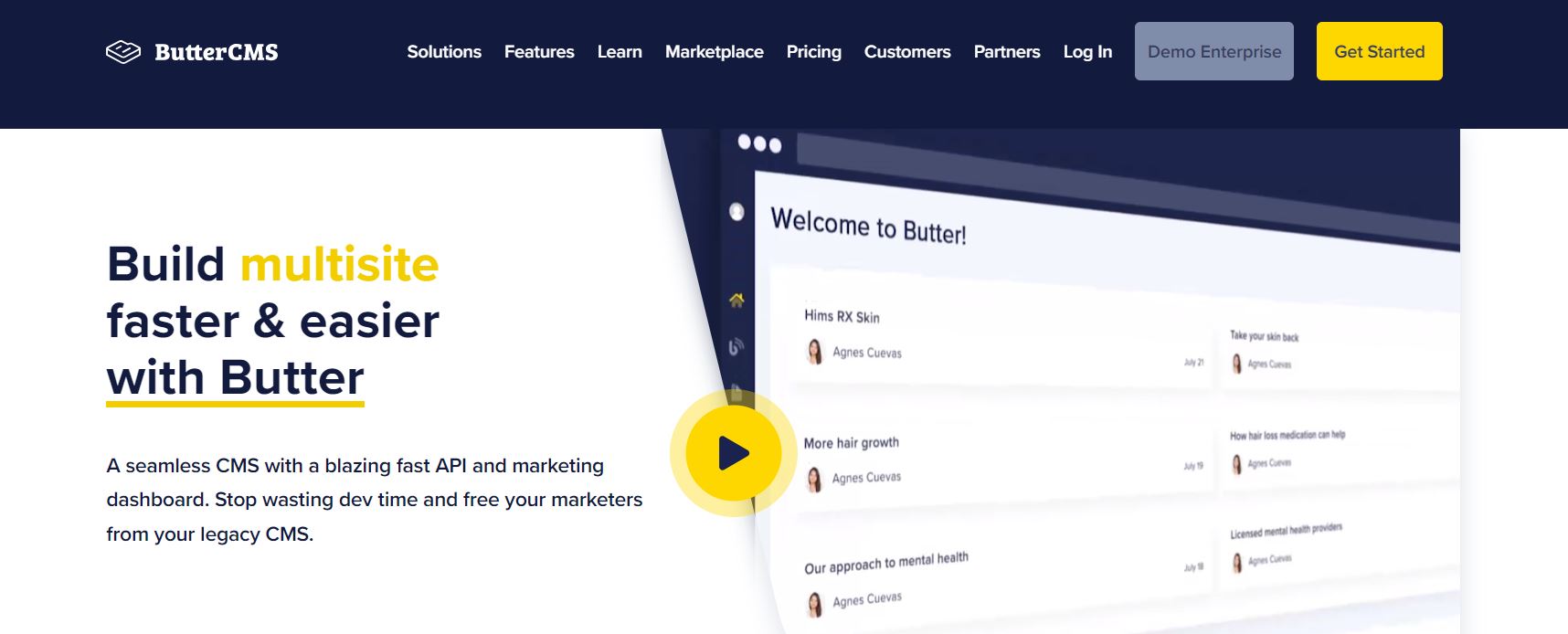
One of the key features of ButterCMS is its ease of integration. It provides a simple and well-documented API that developers can use to fetch content from the CMS and display it on their websites or applications. This API-first approach allows developers to use their preferred programming languages and frameworks, including PHP, to build custom solutions that meet their specific needs.
Pros:
- Headless architecture: ButterCMS follows a headless architecture, decoupling the content management backend from the frontend presentation layer. This allows developers to use their preferred frontend technologies, frameworks, and tools to create custom user experiences.
- Modern API: ButterCMS provides a contemporary, developer-friendly API that enables seamless integration with any programming language or platform. Its RESTful API allows developers to retrieve and manipulate content easily, making it ideal for building dynamic and content-driven applications.
- User-friendly interface: ButterCMS boasts a user-friendly admin interface that makes it easy for content editors to create and manage content without technical expertise. Its intuitive content editing tools and drag-and-drop functionality streamline the content management process.
Cons:
- Limited functionality: ButterCMS focuses solely on content management and lacks some advanced features in traditional CMS platforms. Users may need to rely on third-party services or custom development to add additional functionality.
- Dependency on API: ButterCMS’s headless architecture relies heavily on its API for content retrieval and management. Any downtime or changes to the API may impact the functionality of applications relying on ButterCMS for content.
3 Important Things to Think About When Choosing the Best CMS for PHP
User Support:
When using a CMS, it’s important to get help if you run into any problems. Some CMS platforms have special forums where users can ask questions and get help from others who use the same software. These communities are great because people are happy to help each other with technical issues.
Design Templates:
One of the good things about CMS for PHP is that you can choose from various design templates. Some CMS frameworks come with pre-made templates, so you don’t have to start from scratch. It’s even better to customize these templates without knowing how to code.
Easy to Use:
Even if you’re not a tech expert, the best CMS platforms are easy to understand and use. They have simple interfaces that make adding text, images, videos, and other content to your website easy. It’s important to be able to make changes easily.
Wrap up
After reading this article, we believe you’ll know how different PHP content management system frameworks can help with your upcoming web design project. Make a list of what you’re looking for, and pick the best PHP CMS framework that meets all your needs.




